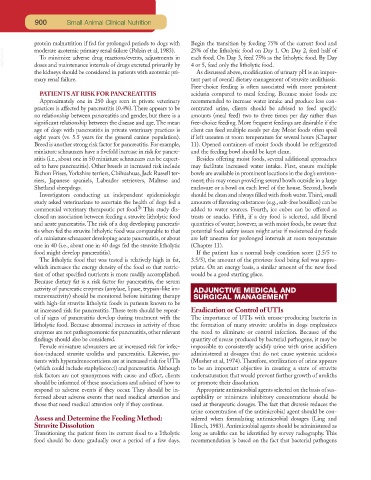Page 869 - Small Animal Clinical Nutrition 5th Edition
P. 869
900 Small Animal Clinical Nutrition
protein malnutrition if fed for prolonged periods to dogs with Begin the transition by feeding 75% of the current food and
VetBooks.ir moderate azotemic primary renal failure (Polzin et al, 1983). 25% of the litholytic food on Day 1. On Day 2, feed half of
To minimize adverse drug reactions/events, adjustments in
each food. On Day 3, feed 75% as the litholytic food. By Day
doses and maintenance intervals of drugs excreted primarily by
4 or 5, feed only the litholytic food.
the kidneys should be considered in patients with azotemic pri- As discussed above, modification of urinary pH is an impor-
mary renal failure. tant part of overall dietary management of struvite urolithiasis.
Free-choice feeding is often associated with more persistent
PATIENTS AT RISK FOR PANCREATITIS aciduria compared to meal feeding. Because moist foods are
Approximately one in 250 dogs seen in private veterinary recommended to increase water intake and produce less con-
practices is affected by pancreatitis (0.4%). There appears to be centrated urine, clients should be advised to feed specific
no relationship between pancreatitis and gender, but there is a amounts (meal feed) two to three times per day rather than
significant relationship between the disease and age.The mean free-choice feeding. More frequent feedings are desirable if the
age of dogs with pancreatitis in private veterinary practices is client can feed multiple meals per day. Moist foods often spoil
eight years (vs. 5.5 years for the general canine population). if left uneaten at room temperature for several hours (Chapter
Breed is another strong risk factor for pancreatitis. For example, 11). Opened containers of moist foods should be refrigerated
miniature schnauzers have a fivefold increase in risk for pancre- and the feeding bowl should be kept clean.
atitis (i.e., about one in 50 miniature schnauzers can be expect- Besides offering moist foods, several additional approaches
ed to have pancreatitis). Other breeds at increased risk include may facilitate increased water intake. First, ensure multiple
Bichon Frises, Yorkshire terriers, Chihuahuas, Jack Russell ter- bowls are available in prominent locations in the dog’s environ-
riers, Japanese spaniels, Labrador retrievers, Maltese and ment; this may mean providing several bowls outside in a large
Shetland sheepdogs. enclosure or a bowl on each level of the house. Second, bowls
Investigators conducting an independent epidemiologic should be clean and always filled with fresh water.Third, small
study asked veterinarians to ascertain the health of dogs fed a amounts of flavoring substances (e.g., salt-free bouillon) can be
b
commercial veterinary therapeutic pet food. This study dis- added to water sources. Fourth, ice cubes can be offered as
closed an association between feeding a struvite litholytic food treats or snacks. Fifth, if a dry food is selected, add liberal
and acute pancreatitis. The risk of a dog developing pancreati- quantities of water; however, as with moist foods, be aware that
tis when fed the struvite litholytic food was comparable to that potential food safety issues might arise if moistened dry foods
of a miniature schnauzer developing acute pancreatitis, or about are left uneaten for prolonged intervals at room temperature
one in 40 (i.e., about one in 40 dogs fed the struvite litholytic (Chapter 11).
food might develop pancreatitis). If the patient has a normal body condition score (2.5/5 to
The litholytic food that was tested is relatively high in fat, 3.5/5), the amount of the previous food being fed was appro-
which increases the energy density of the food so that restric- priate. On an energy basis, a similar amount of the new food
tion of other specified nutrients is more readily accomplished. would be a good starting place.
Because dietary fat is a risk factor for pancreatitis, the serum
activity of pancreatic enzymes (amylase, lipase, trypsin-like im- ADJUNCTIVE MEDICAL AND
munoreactivity) should be monitored before initiating therapy SURGICAL MANAGEMENT
with high-fat struvite litholytic foods in patients known to be
at increased risk for pancreatitis. These tests should be repeat- Eradication or Control of UTIs
ed if signs of pancreatitis develop during treatment with the The importance of UTIs with urease-producing bacteria in
litholytic food. Because abnormal increases in activity of these the formation of many struvite uroliths in dogs emphasizes
enzymes are not pathognomonic for pancreatitis, other relevant the need to eliminate or control infection. Because of the
findings should also be considered. quantity of urease produced by bacterial pathogens, it may be
Female miniature schnauzers are at increased risk for infec- impossible to consistently acidify urine with urine acidifiers
tion-induced struvite uroliths and pancreatitis. Likewise, pa- administered at dosages that do not cause systemic acidosis
tients with hyperadrenocorticism are at increased risk for UTIs (Musher et al, 1974). Therefore, sterilization of urine appears
(which could include staphylococci) and pancreatitis. Although to be an important objective in creating a state of struvite
risk factors are not synonymous with cause and effect, clients undersaturation that would prevent further growth of uroliths
should be informed of these associations and advised of how to or promote their dissolution.
respond to adverse events if they occur. They should be in- Appropriate antimicrobial agents selected on the basis of sus-
formed about adverse events that need medical attention and ceptibility or minimum inhibitory concentrations should be
those that need medical attention only if they continue. used at therapeutic dosages. The fact that diuresis reduces the
urine concentration of the antimicrobial agent should be con-
Assess and Determine the Feeding Method: sidered when formulating antimicrobial dosages (Ling and
Struvite Dissolution Hirsch, 1983). Antimicrobial agents should be administered as
Transitioning the patient from its current food to a litholytic long as uroliths can be identified by survey radiography. This
food should be done gradually over a period of a few days. recommendation is based on the fact that bacterial pathogens

